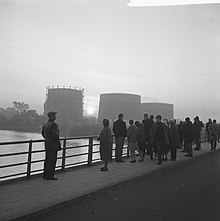Comet Ikeya–Seki
- There are two comets named Ikeya–Seki: C/1965 S1 (this one), and C/1967 Y1, a.k.a. 1968 I, 1967n.
Semi-major axis 91.6 AU (A) | 103.7 (B) AU | |
| Eccentricity | 0.999915 (A) 0.999925 (B) | |
|---|---|---|
| Orbital period | 795 years (epoch 2200 for A)[2] 946 years (epoch 2200 for B)[3] | |
| Inclination | 141.8642° (A) 141.861° (B) | |
| Last perihelion | October 21, 1965[1] | |
Comet Ikeya–Seki,
Comets can defy such predictions, but Ikeya–Seki performed as expected. As it approached
The comet was seen to break into three pieces just before its perihelion passage. The three pieces continued in almost identical orbits, and the comet re-appeared in the morning sky in late October, showing a very bright tail. By early 1966, it had faded from view as it receded into the outer Solar System.
Ikeya–Seki is a member of the
Discovery and observational history

Comet Ikeya–Seki was independently discovered on 18 September 1965 by Japanese amateur astronomers
Ikeya–Seki reached perihelion at 21:18
Structure and composition

Observations obtained by the
Observing campaigns
Ikeya–Seki's perihelion presented a unique opportunity for astrophysical observations to be taken of a bright comet passing extremely close to the Sun.
Gallery
-
Comet Ikeya–Seki, seen from Canberra, 31 October 1965. Drawing by David Nicholls.
-
Comet Ikeya–Seki, 30 October 1965. Photo byJames W. Young (TMO/JPL/NASA)
Notes
- visible light. A more negative value for apparent magnitude indicates a brighter object.
References
- ^ a b "JPL Small-Body Database: C/1965 S1-A (Ikeya-Seki)". Jet Propulsion Laboratory. Retrieved 26 August 2023.
- barycenter(Sun+Jupiter). Select Ephemeris Type:Elements and Center:@0)
- barycenter(Sun+Jupiter). Select Ephemeris Type:Elements and Center:@0)
- ^ "Brightest comets seen since 1935". International Comet Quarterly. Archived from the original on 28 December 2011. Retrieved 12 October 2023.
- ^ a b c d e f g h i j Hale, Alan (24 October 2020). "Comet of the Week: Ikeya-Seki 1965F". RocketSTEM. RocketSTEM Media Foundation. Retrieved 15 May 2023.
- ^ JSTOR 40674261.
- ^ JSTOR 40674283.
- Bibcode:1965PASJ...17..433H.
- ^ JSTOR 40674308.
- ^ JSTOR 40674376.
- doi:10.1086/110884.
External links
![]() Media related to Comet Ikeya-Seki at Wikimedia Commons
Media related to Comet Ikeya-Seki at Wikimedia Commons




